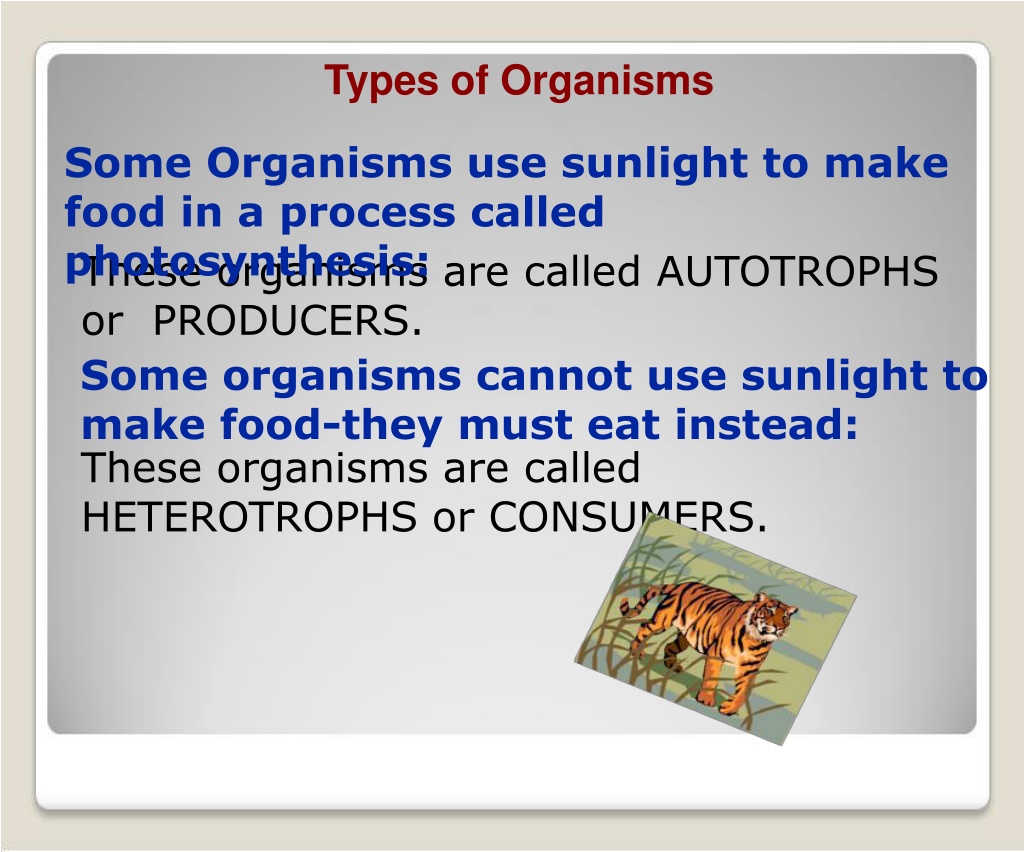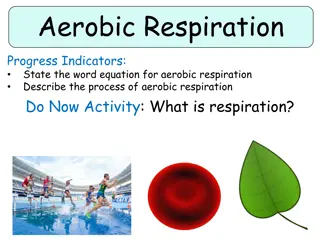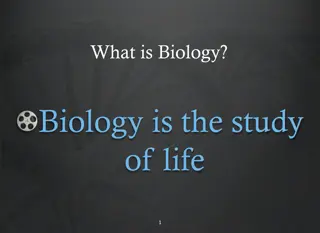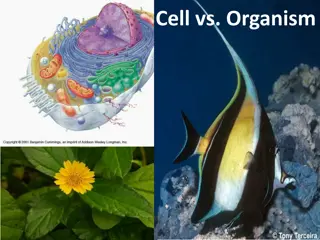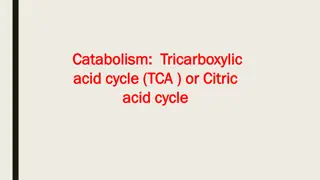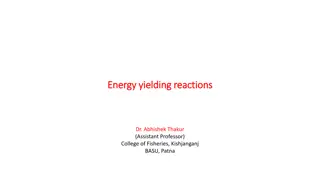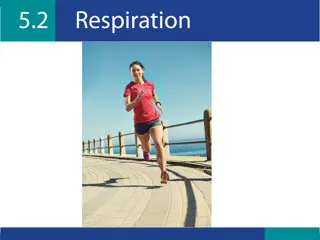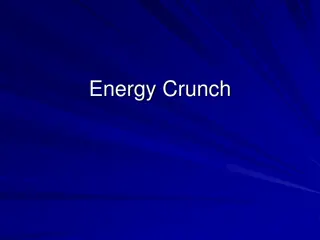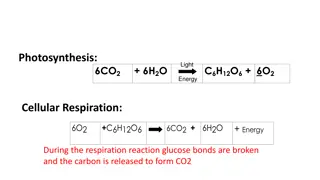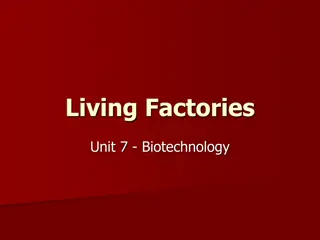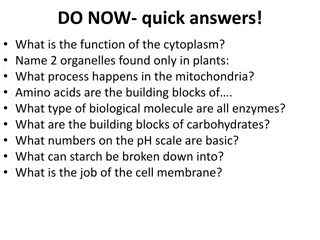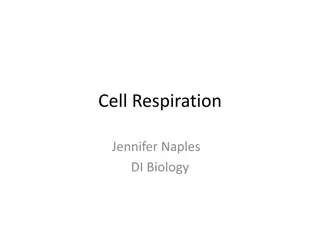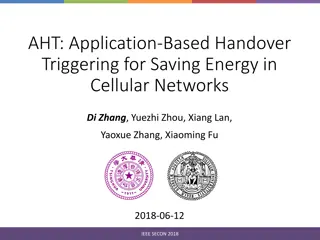Understanding Cellular Respiration: Energy Production in Organisms
Organisms can be classified into autotrophs that use sunlight for photosynthesis and heterotrophs that rely on consuming food. Regardless of food source, all organisms obtain energy through cellular respiration, a process that converts stored chemical energy into ATP. This energy currency is essential for various cellular functions, with ATP being considered as "free energy" for cellular work. Cellular respiration is a catabolic, exergonic, aerobic process that breaks down glucose to produce ATP, requiring oxygen. It is similar to breathing but occurs at the cellular level, involving the exchange of oxygen and carbon dioxide. Overall, cellular respiration is crucial for generating up to 38 ATP molecules per glucose molecule consumed.
Download Presentation

Please find below an Image/Link to download the presentation.
The content on the website is provided AS IS for your information and personal use only. It may not be sold, licensed, or shared on other websites without obtaining consent from the author. Download presentation by click this link. If you encounter any issues during the download, it is possible that the publisher has removed the file from their server.
E N D
Presentation Transcript
Types of Organisms Some Organisms use sunlight to make food in a process called photosynthesis: These organisms are called AUTOTROPHS or PRODUCERS. Some organisms cannot use sunlight to make food-they must eat instead: These organisms are called HETEROTROPHS or CONSUMERS.
Types of Organisms No matter how organisms get their food ALL get their energy FROM THE FOOD in the SAME way. Cellular Respiration
Cellular Respiration Cellular Respiration is a Process in which organisms create ATP from the food they make or eat.
Cellular Respiration During Cellular Respiration we take potential energy (stored energy) called chemical energy stored in the bonds of glucose and turn it into ATP. ATP is called free energy because it is available to do any type of work needed in our cells called Kinetic Energy (energy available for work) The amount of energy released is measure in calories or kilocalories The more energy a type of food can release the more calories it has
Cellular Respiration Cellular Respiration: catabolic, exergonic, aerobic process that uses energy to extract ATP (adenosine triphosphate) from an organic molecule called glucose Catabolic: breaks molecules down Exergonic: releases energy Aerobic: oxygen (O2) requiring
Cellular Respiration Cellular Respiration is similar to breathing and respiration Breathing and respiration is an exchange of oxygen and carbon dioxide between blood and the outside air Cellular respiration is the exchange of oxygen and carbon dioxide between the cells and the blood
Cellular Respiration Makes up to 38 ATP Cellular Respiration uses the glucose we eat and the glucose plants make as well as the oxygen we breathe to create up to 38 ATP as well as the carbon dioxide we breathe out and water.
What is ATP? Adenosine Tri-Phospate: Made of three things 1.) Ribose (sugar) 2.) Adenosine (base) 3.) Three phosphates Key to the activity of ATP is release energy as the bonds break between the phosphates
ATP ADP AMP ATP to ADP To ADP releases energy
Cellular Respiration Cellular Respiration takes place in three stages and in different places of the cell. Glycolysis: Cytoplasm (cytosol)Mitochondrial Krebs Cycle: Mitochondrial Matrix Electron Transport Chain: Inner Mitochondrial Membrane
Cellular Respiration: Mitochondria The mitochondria is designed to complete cellular respiration with maximum energy production. > There are many folds in the membrane to increase surface area and allows many reactions of Cellular Respiration to occur at once. This produces a lot of ATP.
Cellular Respiration Cellular Respiration is broken into three main parts. 1.) Glycolysis: sugar splitting phase (glucose is the sugar) 2.) Krebs Cycle (Citric Acid Cycle): Extracts the energy from glucose 3.) Electron Transport Chain/ATP Synthase: Turns the energy into ATP for the body to use
Stage 1: Glycolysis Location: Occurs in the cytoplasm just outside of mitochondria in two phases. A. Energy investment phase Put 2 ATP in to start the reaction B. Energy yielding phase Create 4 ATP MAIN GOAL: To split glucose
Glycolysis Process: Invest 2 ATP to start the reaction Split glucose molecule in half to create two molecules of Pyruvic Acid Produces two molecules of NADH from NAD+ Produces 4 new ATP molecules NET GAIN: 2 ATP (4 Produced - 2 Invested)
Glycolysis Products 2 ADP Molecules 2 Pyruvate Molecules 2 NADH Molecules 4 ATP Molecules Reactants 2 ATP Molecules 1 Glucose Molecule 2 NAD+ Molecules 4 ADP Molecules
Krebs Cycle (Citric Acid Cycle) Location: Mitochondrial Matrix Main Goal: Break down pyruvate to carbon dioxide and release more energy Process: Diffuse pyruvic acid into the matrix of the mitochondria Each pyruvate loses one carbon and makes a 2 carbon molecule called Acetyl CoA The carbon join with the oxygen (aerobic) that breathe in to create the carbon dioxide we breathe out Acetyl CoA now enters the mitochondria
Krebs Cycle (Citric Acid Cycle) Since there are two molecules of Pyruvic Acid entering the krebs cycle there must be two turns of the cycle. One for each pyruvate. 1. 2.
Krebs Cycle (Citric Acid Cycle) Reactants: Products from glycolysis Pyruvate to Acetyl CoA ADP Oxygen FAD NAD+ Products: 4 Carbon Molecule to be recycled ATP Carbon Dioxide FADH2 NADH
Electron Transport Chain Location: Inner Membranes of Mitochondria Main Goal: Use hydrogen ions and electrons to make up to 34 ATP Process: -All NADH and FADH2 are electron carrier - Made from glycolysis and krebs cycle NADH and FADH2 donate electrons and hydrogen ions to make ATP molecules
Electron Transport Chaine Reactants: ALL NADH and FADH2 from glycolysis and the krebs cycle ADP Products: NAD+ and FAD ATP
Fermentation In some cases there is little to no oxygen present and organisms still need energy. Since cellular respiration is an aerobic process it cannot occur with out oxygen. -Fermentation occurs when no oxygen is present (anaerobic) -Two Types 1. Lactic Acid: Completes glycolysis and produces lactic acid 2. Alcoholic: Completes glycolysis and produces alcohol
